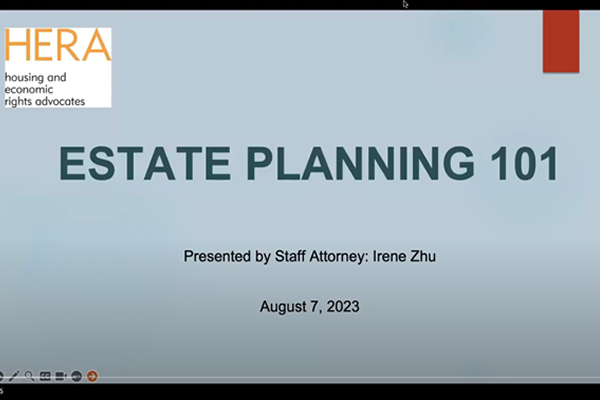Keeping Your House Out of Probate
Your home is often your largest asset, and something you want to ensure transfers according to your wishes after your death. Without any advanced planning, your loved ones may be saddled with a complicated court procedure after you’re gone in order to transfer your home to your heirs. Luckily, there are several ways this can be avoided. Some of the most common methods are discussed below.
If you own your home with your spouse or another person, it may already be set up to transfer easily to the co-owner upon your death. Property held as “joint tenants” or as “community property with right of survivorship” will transfer easily to the remaining owner(s) upon the death of one owner. Property held in other manners may require a court order to transfer title after the death of one owner.
If your home is already in the name of two or more people, you may want to check your deed, to confirm that the owners hold title in the manner that will facilitate the transfer after one owner’s death. For more information about the different ways to hold title, see the Law Library’s guide, “Completing and Recording Deeds.”
Given this information, many people are tempted to add their children or others to their deed as joint tenants, to facilitate transfer after their death. While this does work for that purpose, adding names now, while you are still alive, does pose some concerns. Once a name is added to the deed, that person immediately becomes a part owner of the property, and their name cannot be removed without their permission. This means you can’t change your mind. It also means that your heirs’ creditors can put liens on the house; you will need the additional owners’ permission to sell or refinance your home; the newly added owners can transfer their portion of the property to someone else without your consent; and the newly added owners may even have a right to live in the property. There are also tax considerations, both at the time of the transfer, and upon the death of one owner.
To avoid these problems, you may want to consider some form of estate planning to ensure that your home and any other assets you may have are transferred according to your wishes.
The first thing most people think of when talking about estate planning is a will. Wills are a great way to identify who you would like to inherit your assets after your death, but they do not provide an easy way to transfer real property. You can certainly use a will to name who you would like to inherit your home upon your death, but without any other estate planning device in place, the transfer will likely require a court order.
Other estate planning methods will allow your heirs to transfer property without going to court.
One common method is to create a revocable trust. A revocable trust allows you to maintain control of your property during your life, and decide how the property is distributed after death, without needing to go through probate court. Your trust can include your home and any other assets you have, making it a comprehensive solution for your entire estate. After your death, the person you choose as trustee simply distributes the property as directed in the trust.
If you are comfortable with detailed instructions and forms, you can create a simple trust with the help of a self-help book. The Law Library has several of these types of books available. However, if you have numerous or complicated assets, or a complicated family situation such as children from multiple marriages or long-term unmarried partners, or if you expect disputes between your potential heirs, you may want to consult an attorney. A lawyer can help you create a trust that best suits both your assets and your wishes, which will help avoid the costs and emotional impact of court disputes after you are gone.
California lawmakers realized that estate planning can be difficult and costly, especially for those whose main concern is ensuring their house transfers according to their wishes. In January 2016, California adopted a law allowing a new type of deed, called a Revocable Transfer on Death (TOD) deed. In 2022, the law was changed to provide additional protections to homeowners and their heirs.
TOD deeds allow you to name beneficiaries who will receive the property when you die, without the need for probate. With the TOD deed, you remain the owner of your property. Your heirs do not own any portion of the property during your life, avoiding the problems discussed above. You can also revoke this deed at any time, if you change your mind about who you’d like to inherit your property. TOD deeds are easy to set up; you just complete a form, sign in front of a notary, and have two witnesses sign as well. Then you record it with the County Recorder within 60 days.
When you pass away, your heirs just record a simple form with the County Recorder to transfer the property into their name. The transfer is treated as an inheritance, not a gift, so it gets more favorable tax treatment. For more information on creating, revoking, and clearing title with TOD deeds, see the Law Library’s step by step guides, “Transfer on Death (TOD) Deed” and “Transferring Title to Beneficiaries after a Transfer on Death Deed Takes Effect.”
mpj 5/23
Related Video
Estate Planning Basics

You worked hard for your home and your other assets. You likely want to pass that legacy on to your family after your death. Passing on the family home can make it possible for your kids and grandkids to stay in their community or go to college. Learn the basics of how to set up an estate plan to prepare for the management of your assets during your lifetime if you can no longer take care of them yourself and set up a plan for the distribution of your assets following your death.
This material is intended as general information only. Your case may have factors requiring different procedures or forms. The information and instructions are provided for use in the Sacramento County Superior Court. Please keep in mind that each court may have different requirements. If you need further assistance consult a lawyer.




